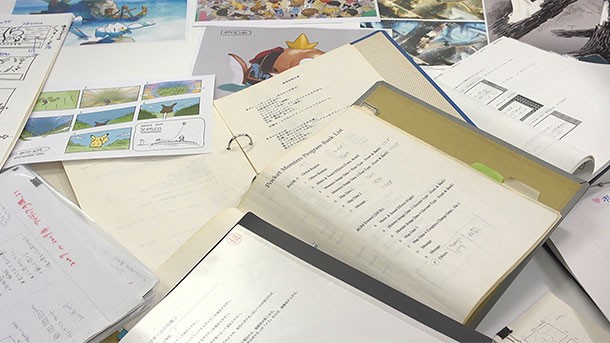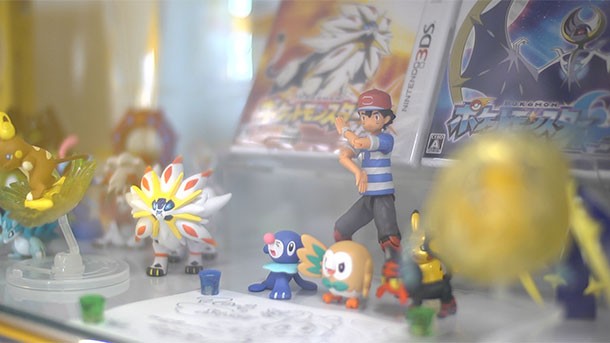Here's How Game Freak Designs Pokémon Creatures

Between all the different Pokémon games that have released over the last 20 years, taking into account Mega Evolutions and new wrinkles like the Alola forms in Sun and Moon, there are 802 Pokémon. The creatures vary in design to an incredible degree, covering strange influences like keys and piles of garbage to less surprising designs based on cute animals like cats and koalas. While visiting Japan to explore Game Freak’s development studio, we spoke with Pokémon director, producer, and composer Junichi Masuda about what the process of designing a Pokémon looks like, whether they have ever encountered an internal pitch that was immediately turned down, and what has happened to their eyes over the years.
Pitches for new creatures come from every corner of the studio. “The graphic designers are obviously going to be the ones finalizing the look, but it’s not just the graphic designers who come up with ideas or draw the Pokémon,” Masuda says. Sometimes a battle designer might want to feature a specific move in the game, which requires a specific creature. A story writer might want to execute a narrative beat that requires a new monster. Alternatively, it might be as simple as a graphic designer wanting to explore an animal that it has not yet inspired a Pokémon yet. “These ideas come from a lot of different places, the gameplay, the visuals, the story, and in the end those ideas just get centralized and designed,” Masuda says.

A glass case in one of Game Freak's meeting spaces features a figurine of every Pokémon. Or at least, they're pretty sure it has every one. There are over 800 after all.
There are few, if any, hard and fast rules about what a Pokémon can and cannot be. “One thing we always really pay attention to is treating them like living creatures so you have to try and imagine where it would live in the environment and why it looks the way it does, what would it eat? For example,” Masuda says. “When designing Pokémon, and not just from a graphic design perspective, there must be a reason for why it looks the way it does and you have to think about why it might live in the Pokémon world.”

Pokémon designs rarely get cancelled, so to speak. If a new Pokémon weren’t going to fit in the game or world, Game Freak doesn’t let them get far past the conceptual stages. “Once you’re in the middle of creating it and someone were to say, ‘No!, that’s not a Pokémon,’ and the design process gets killed? That doesn’t really happen that much,” Masuda says. “Usually, instead, maybe the person who is directing the game might say it won’t work in its current form, but maybe if you did this and adding ideas onto it might make it work better.” For this reason, ideas for new Pokémon rarely get thrown away.
Game Freak has been working on Pokémon for just over 20 years, so it knows what makes a good Pokémon at this point, but evolution tracks can still be tricky. “One thing that happens a lot – well, not a lot – but happens sometimes, is that you start out with a cat, and when it evolves one easy idea is to say, ‘Okay, now there’s more heads’,” Masuda says, going to the whiteboard behind him to illustrate his point. “We always want to make sure we think, ‘Why does that happen?’ And when it evolves why does it have three heads? So that’s just something we’re always trying to think of – what’s the reason for what changes and how it looks?” After hastily drawing the three-headed cat used to illustrate his point, Masuda laughs saying, “Even if I said I really wanted to make this, I would probably get shot down.”

Compare the eyes of a first generation Pokémon to the eyes of Popplio, a generation seven Pokémon.
The design process over the years has not remained totally consistent, however, and the community does notice when it shifts. Recently, Reddit user IanMazgelis created a post that gained popularity specifically pointing out the way Pokémon’s eyes have changed over the years. Early Pokémon designs feature sharp eyes that were more angular, while later designs round the eyes for a generally softer look. We showed Masuda IanMazgelis’ post in order to find out why the eyes have changed. “It’s definitely conscious of the evolving design, but some of the reason behind that, for example, is in the beginning, the Game Boy had a really limited palette and a very small amount of pixels to express the designs,” Masuda says. “It was hard to make circles so that was one reason a lot of them had a similar look. As the technology evolved we had more options for expression with different shapes and more variety, so I think we’ve focused on trying to have a lot of variety in the eyes, for example.”
The design and process of creating new Pokémon will likely shift and change as the series moves forward, adapting to who is working in the studio and what ideas the studio wants to convey. It’s reassuring to know, however, that nearly no idea is out of bounds.
For more on the history of Pokémon, you can check out the latest issue for a 12-page feature covering the franchise’s history, as well as online features and interviews linked below.
- Pokémon’s Developers Talk About Their Console RPG Debut On Switch
- Game Freak’s Origins And Its Pre-Pokémon Games
- Here's How Game Freak Designs Pokemon Creatures
- Game Freak On Player Freedom Vs. Story In Pokémon
- Discussing Our In-Depth Tour Of Game Freak
- Everything We Know About Pokémon On The Nintendo Switch
- Why Ruby And Sapphire Were The Most Challenging Pokémon To Make
- Game Freak's Director Share Their Favorite Pokémon Spin-Offs
- An Exclusive Look At Pokémon's Early Design Documents
- Pokémon’s Creators On The Anime: 'We Weren't Really Sure About It'
- Our Reddit AMA On Our Trip To Visit Game Freak
- Exclusive Reveal Of A New Mode In Pokémon Ultra Sun And Moon

Get the Game Informer Print Edition!
Explore your favorite games in premium print format, delivered to your door.
- 10 issues per year
- Only $4.80 per issue
- Full digital magazine archive access
- Since 1991









